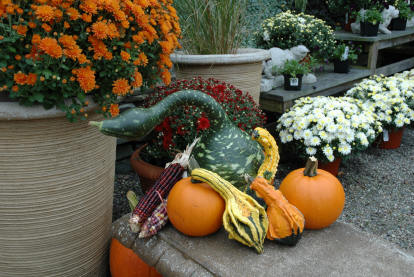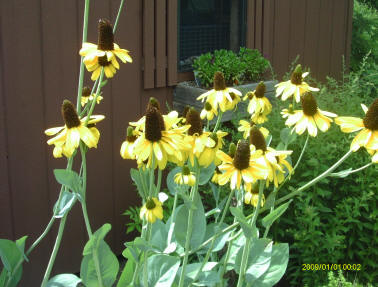(9/2016) This native plant may catch our eye while traveling throughout the mid-Atlantic as well as across the nation in mid to late summer. Seen in many gardens and along roadsides, the Rudbeckia is a summer highlight. Commonly called a black eyed Susan, this genus is as diverse as any plant.
 Generally, the Rudbeckias like full sun. They will grow well in medium to dry soils, evidenced by their ability to grow along roadsides. They have the capability to self-sow, making it a great plant to use when developing meadows and wildflower borders. Needing little care, this
group of plants is a natural for any garden setting, whether it’s a "wild" garden or a well -manicured garden.
Generally, the Rudbeckias like full sun. They will grow well in medium to dry soils, evidenced by their ability to grow along roadsides. They have the capability to self-sow, making it a great plant to use when developing meadows and wildflower borders. Needing little care, this
group of plants is a natural for any garden setting, whether it’s a "wild" garden or a well -manicured garden.
Three of my favorite species are Rudbeckia triloba, Rudbeckia fulgida, and Rudbeckia maxima. R. triloba, often referred to as the brown eyed susan (for what reason, I have no idea), has a small flower, only about 1"-2" across. The plant reaches 3’ tall, and is quite showy, as all Rudbeckias are. This is considered a biennial or short lived
perennial. In my garden, it’s definitely a biennial, meaning it drops seeds in summer/fall and grows a rosette of leaves, then flowers the second year. This sweet little flower moves around in the garden, so when introducing this plant, know that seedlings will pop up in unplanned places. In full sun, it will reach 2’-3’. Unlike many Rudbeckias, it likes moist soil, but
tolerates dry sites. In my garden, it is not selective, dry or moist, I am sure to find this sweet perennial gracing my garden.
 Rudbeckia maxima, a very tall plant with green-gray foliage forming a rosette at the base of the plant, reaches a height of 5’-6’. The flowers stand tall, stretching on long stems well above the 18" rosette of leaves at its base. Often called a coneflower, due to its long cone
and droopy petals, this Rudbeckia has the typical yellow flower with a black center. The gold finches absolutely love this Midwestern native and if planted, will grace the garden with their presence, so much so that gathering the seeds becomes quite a challenge as the goldfinches pick them clean quickly. Due to the short foliage, I like to plant this garden giant in the
foreground so the pretty foliage can be seen all season long. The majestic flower stems will stretch above most other plants and are always the talk of the garden. Although they don’t bloom for a very long period like most Rudbeckias, the foliage is different, adding texture to the sun garden.
Rudbeckia maxima, a very tall plant with green-gray foliage forming a rosette at the base of the plant, reaches a height of 5’-6’. The flowers stand tall, stretching on long stems well above the 18" rosette of leaves at its base. Often called a coneflower, due to its long cone
and droopy petals, this Rudbeckia has the typical yellow flower with a black center. The gold finches absolutely love this Midwestern native and if planted, will grace the garden with their presence, so much so that gathering the seeds becomes quite a challenge as the goldfinches pick them clean quickly. Due to the short foliage, I like to plant this garden giant in the
foreground so the pretty foliage can be seen all season long. The majestic flower stems will stretch above most other plants and are always the talk of the garden. Although they don’t bloom for a very long period like most Rudbeckias, the foliage is different, adding texture to the sun garden.
Rudbeckia hirta is a very showy plant, often called the gloriosa daisy. This plant should be managed as an annual, although sometimes in the mid-Atlantic region, behaves as a biennial. Blooming from summer through fall if deadheaded, this is probably one of the showiest of the Rudbeckias, as the flowers are large - reaching 3" across, and many
flowers bicolored, with brown and yellow color. This year is the first time I’ve planted this guy in my garden, and have not been disappointed with the show. It gets about 2’ tall and is a very bright spot in the garden.
The most common and easiest to find Rudbeckia is R. fulgida. This is probably the longest blooming Rudbeckia and the longest lived. Beginning in mid-July, it will continue to push flowers through September, making it a great companion of Joe Pye Weed, grasses, and sedum. Full sun, well drained to dry soils is best.
Rudbeckia fulgida var. sullivantii, also known as ‘Goldstrum’ Rudbeckia, can be easily found in any nursery. This naturally occurring variation has an abundance of flowers per plant that is difficult to replicate. The flowers are slightly larger than the straight species and have a clear golden color.
Rudbeckia fulgida var speciosa is a slightly shorter variety than the sullivantii, and a common parent of many cultivars. A common cultivar is ‘Viette's Little Suzy’. As it is slightly shorter than ‘Goldstrum’, this particular cultivar is great for containers.
However, a common problem with this particular species is Septoria Leaf Spot. This disease causes black spots, turning to large black blotches on the foliage. As the disease spreads, the stems and flowers will turn brown. Probably the easiest control is to be sure to plant these plants with good air circulation, not squished together with other
plants, or in shady spots. I have had difficulty with this disease in my garden and dug up all of the fulgidas. They were growing in a tight space and being outgrown by some shrubs. That was about five years ago. Now these tough plants have begun to grow in open spaces in my garden by self sowing, where the air circulation is good. A nice compact plant, this is a great
choice for most any full sun garden.
An interesting Rudbeckia is R. lancinata. A very tall perennial, reaching up to 9’, is commonly misidentified as one of our native sunflowers. This is a good choice for a meadow or to the rear of a perennial border where other plants will hold up the droopy stems, as it tends to fall over with the weight of the small yellow flowers. My experience
is that R. lancinata has not been and easy perennial to find in the nursery, probably because of the height, as it doesn’t hold well in a container throughout the summer. However, a shorter version, R. lancinata ‘Golden Drop’ reaches about 5’ tall and has stronger, more supportive stems for the golden yellow flowers.
This species has not been in my radar nor was I aware of its existence until I saw it at our local county fair. R. subtomentosa ‘Henry Eilers’ graced the floral department, and sent me on a quest to find out more. ‘Henry Eilers’ is a perennial Rudbeckia found in Arkansas along a railroad track. Its unique quilled flower petals made it an
interesting selection of the species subtomentosa, a Rudbeckia that typically has flat petals, like other common Rudbeckias. ‘Henry Eilers’ is found in many nurseries, reaches about 5’ tall and a great addition to a full sun garden. Propagation should be done by division, as collected seeds have only been found to produce quilled petals 15%-20% of the time.
The most important part of selecting Rudbeckias is to be sure you know what you’re buying. As you can see for this list, some are perennial, some are biennial and some are annual. To reduce disappointment, do your research. This is a great group of plants worth investigating. Their continual color in late summer through fall can add that needed
touch. The birds and butterflies love them too, making it a great plant for any full sun garden.
Read other articles by Mary Ann Ryan
Read other articles on ecological gardening & native plants
Read other articles on plants and gardens